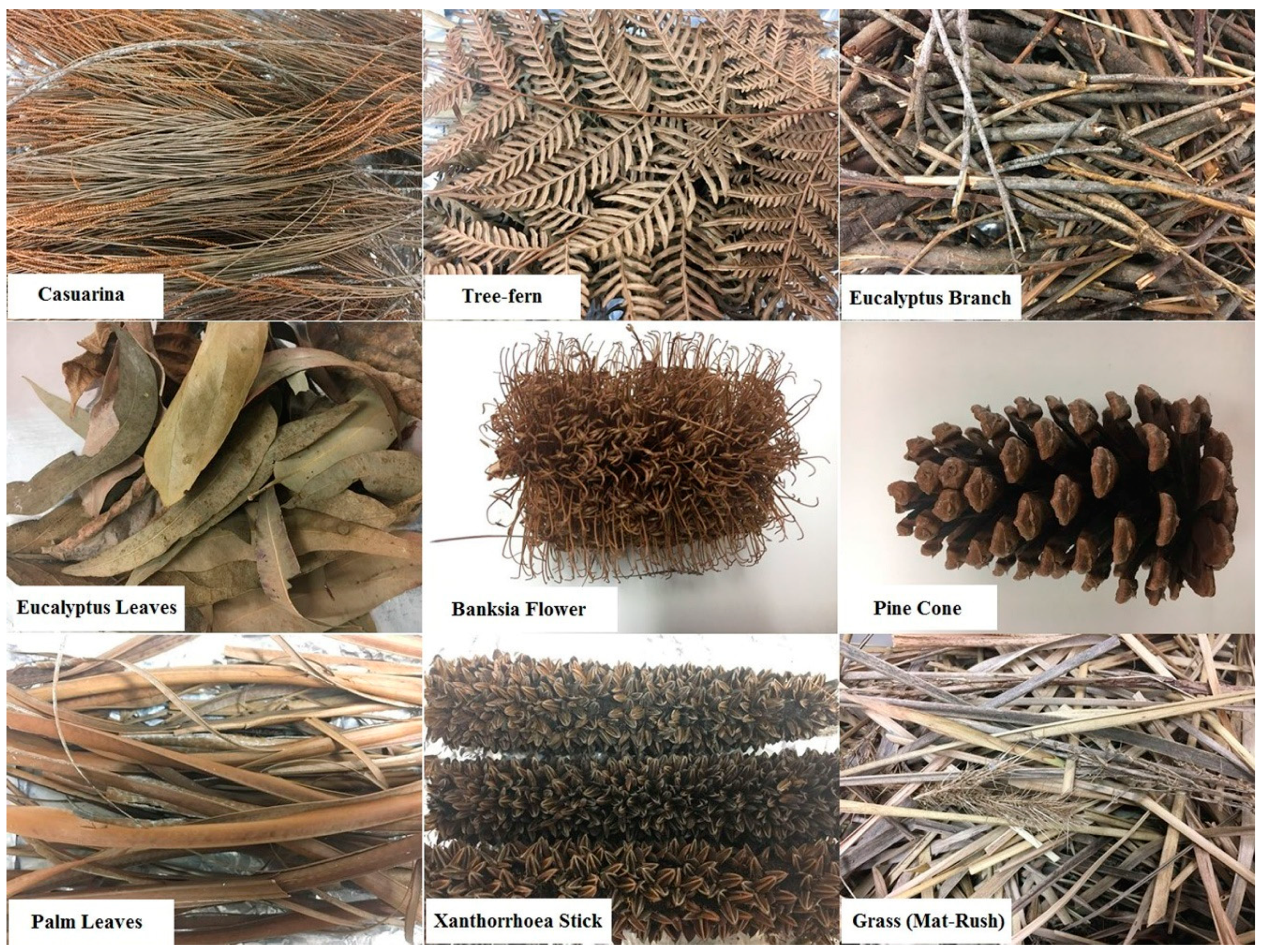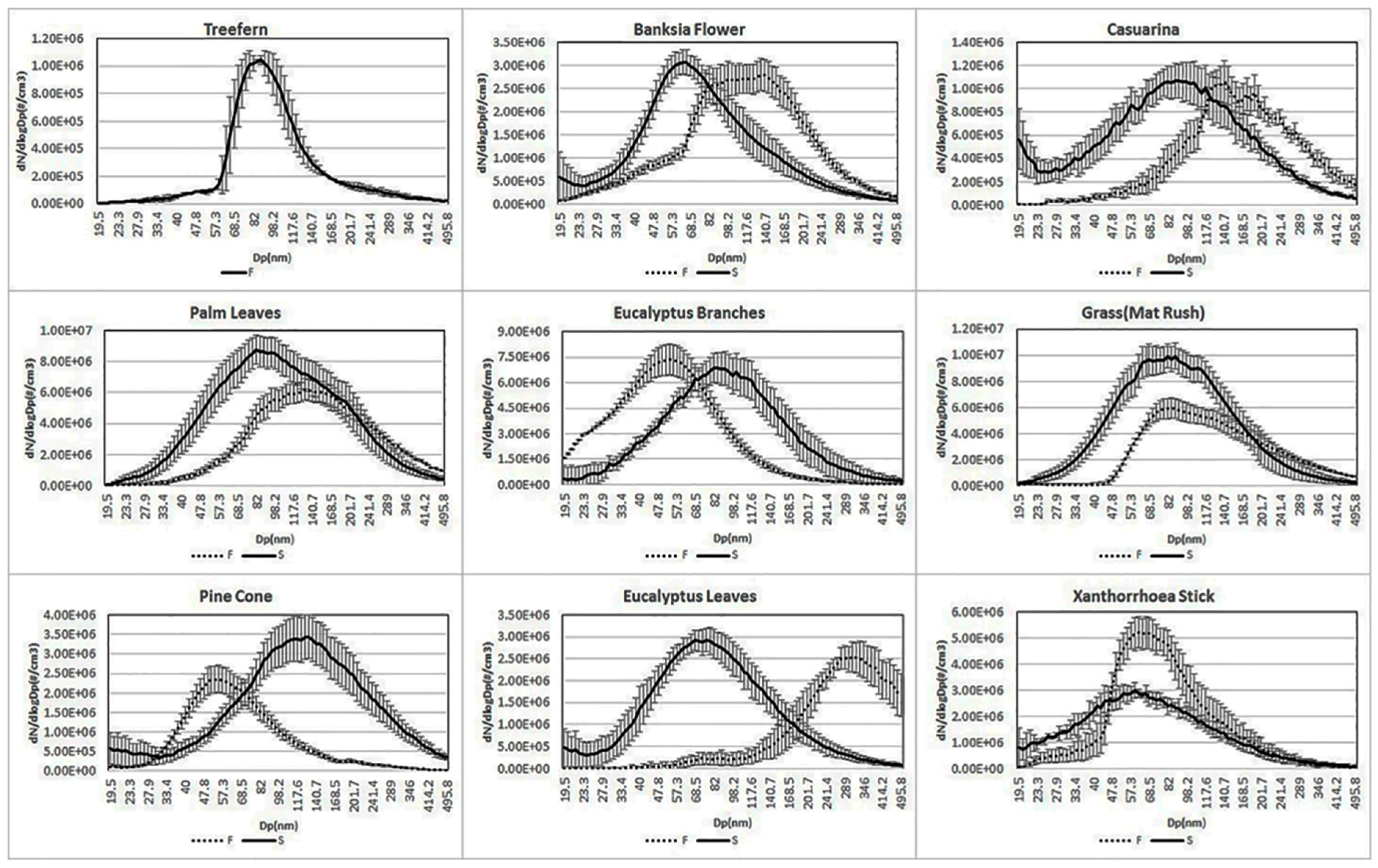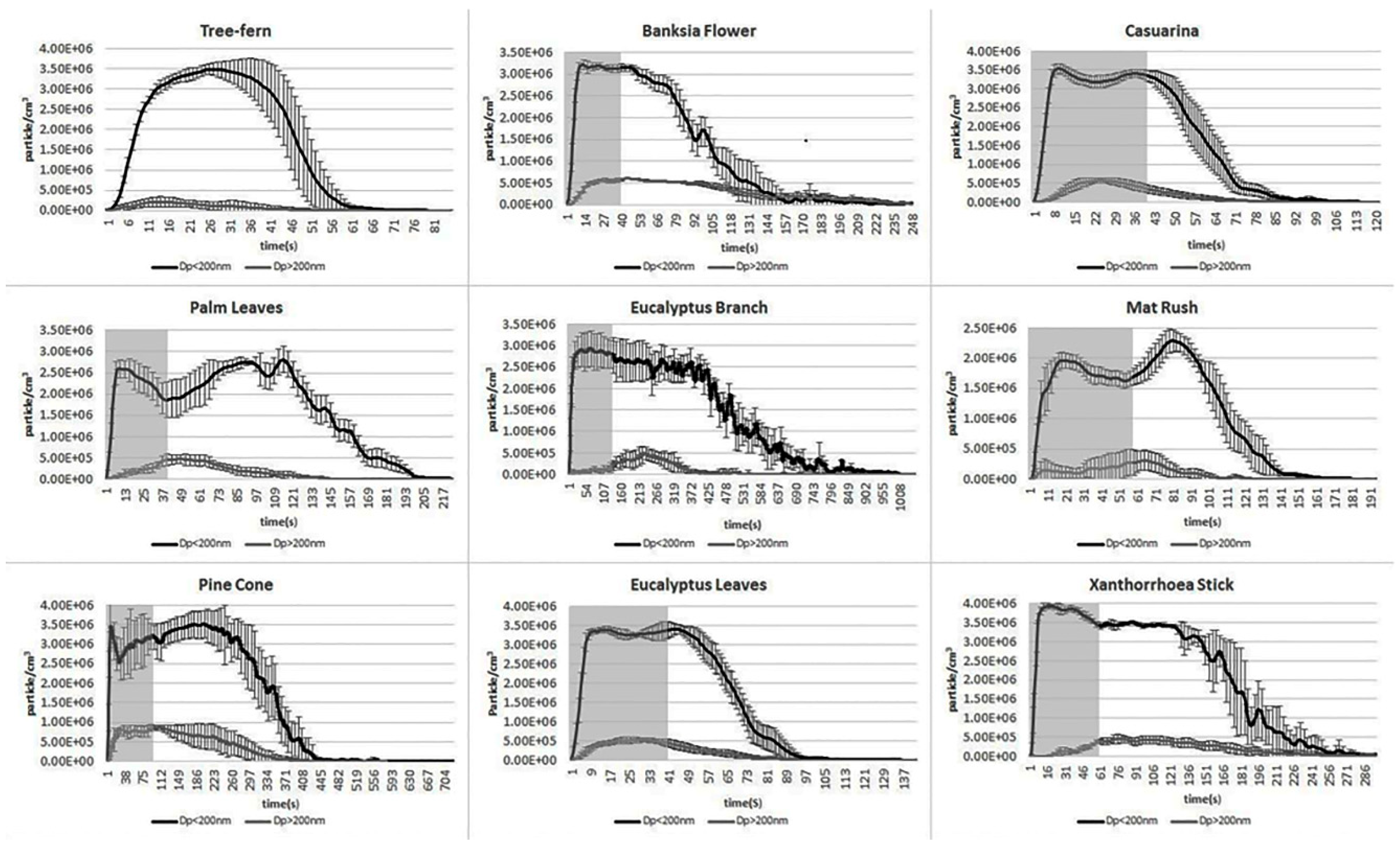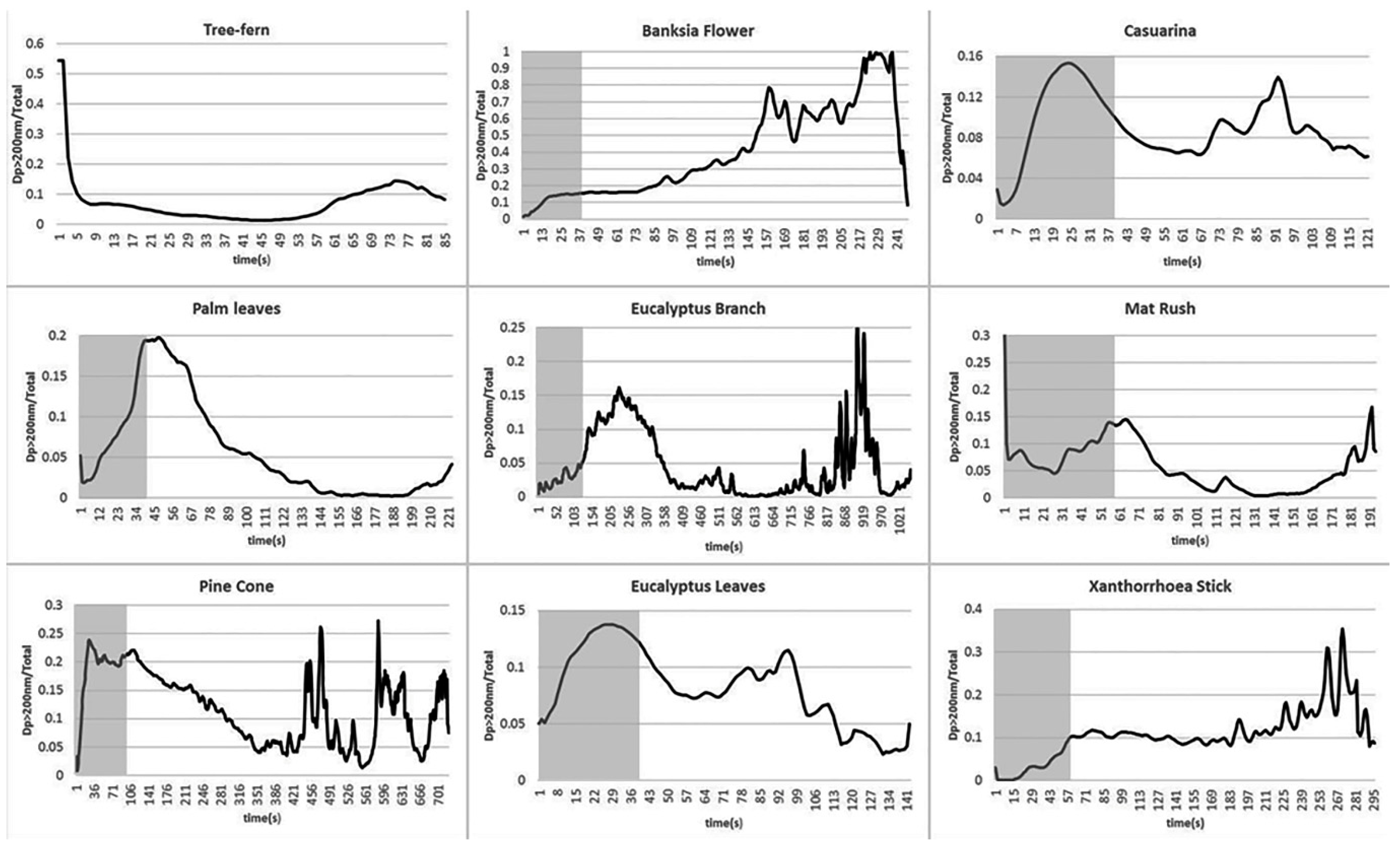Contribution of Fine Particles to Air Emission at Different Phases of Biomass Burning
Abstract
1. Introduction
2. Materials and Methods
2.1. Vegetation Collection and Classification
2.2. Burning and Aerosol Sampling
3. Results and Discussions
4. Conclusions
Author Contributions
Funding
Conflicts of Interest
References
- Ordou, N.; Agranovski, I. Mass distribution and elemental analysis of the resultant atmospheric aerosol particles generated in controlled biomass burning processes. Atmos. Res. 2017, 198, 108–112. [Google Scholar] [CrossRef]
- Mallet, M.; Desservettaz, M.; Miljevic, B.; Milic, A.; Ristovski, Z.; Alroe, J.; Griffith, D.W. Biomass burning emissions in north Australia during the early dry season: An overview of the 2014 SAFIRED campaign. Atmos. Chem. Phys. 2017, 17, 13681–13697. [Google Scholar] [CrossRef]
- Nayek, S.; Padhy, P.K. Daily personal exposure of women cooks to respirable particulate matters during cooking with solid bio-fuels in a rural community of West Bengal, India. Aerosol. Air Qual. Res. 2017, 17, 245–252. [Google Scholar] [CrossRef]
- Karthikeyan, S.; Balasubramanian, R.; Iouri, K. Particulate air pollution from bushfires: Human exposure and possible health effects. J. Toxicol. Environ. Health Part A Curr. Issues 2006, 69, 1895–1908. [Google Scholar] [CrossRef] [PubMed]
- Pope, C.A., III; Dockery, D.W. Health effects of fine particulate air pollution: Lines that connect. J. Air Waste Manag. Assoc. 2006, 56, 709–742. [Google Scholar] [CrossRef]
- Costa, M.A.M.; Carvalho, J.; Neto, T.S.; Anselmo, E.; Lima, B.; Kura, L.; Santos, J. Real-time sampling of particulate matter smaller than 2.5 μm from Amazon forest biomass combustion. Atmos. Environ. 2012, 54, 480–489. [Google Scholar] [CrossRef]
- Bond, T.C.; Doherty, S.J.; Fahey, D.; Forster, P.; Berntsen, T.; DeAngelo, B.; Koch, D. Bounding the role of black carbon in the climate system: A scientific assessment. J. Geophys. Res. Atmos. 2013, 118, 5380–5552. [Google Scholar] [CrossRef]
- Milic, A.; Mallet, M.D.; Cravigan, L.T.; Alroe, J.; Ristovski, Z.D.; Selleck, P.; Paton-Walsh, C. Biomass burning and biogenic aerosols in northern Australia during the SAFIRED campaign. Atmos. Chem. Phys. 2017, 17, 3945–3961. [Google Scholar] [CrossRef]
- Alonso-Blanco, E.; Calvo, A.I.; Pont, V.; Mallet, M.; Fraile, R.; Castro, A. Impact of biomass burning on aerosol size distribution, aerosol optical properties and associated radiative forcing. Aerosol Air Qual. Res. 2014, 14, 708–724. [Google Scholar] [CrossRef]
- Chen, S.-C.; Hsu, S.-C.; Tsai, C.-J.; Chou, C.C.-K.; Lin, N.-H.; Lee, C.-T.; Pui, D.Y. Dynamic variations of ultrafine, fine and coarse particles at the Lu-Lin background site in East Asia. Atmos. Environ. 2013, 78, 154–162. [Google Scholar] [CrossRef]
- Souza, M.L.; Allen, A.G.; Cardoso, A.A. Understanding aerosol formation mechanisms in a subtropical atmosphere impacted by biomass burning and agroindustry. Atmos. Res. 2017, 183, 94–103. [Google Scholar] [CrossRef]
- Janhäll, S.; Andreae, M.O.; Pöschl, U. Biomass burning aerosol emissions from vegetation fires: Particle number and mass emission factors and size distributions. Atmos. Chem. Phys. 2010, 10, 1427–1439. [Google Scholar] [CrossRef]
- Wu, Z.; Zheng, J.; Wang, Y.; Shang, D.; Du, Z.; Zhang, Y.; Hu, M. Chemical and physical properties of biomass burning aerosols and their CCN activity: A case study in Beijing, China. Sci. Total Environ. 2017, 579, 1260–1268. [Google Scholar] [CrossRef]
- Corsini, E.; Vecchi, R.; Marabini, L.; Fermo, P.; Becagli, S.; Bernardoni, V.; Galli, C.L. The chemical composition of ultrafine particles and associated biological effects at an alpine town impacted by wood burning. Sci. Total Environ. 2017, 587, 223–231. [Google Scholar] [CrossRef]
- Sarigiannis, D.A.; Karakitsios, S.P.; Zikopoulos, D.; Nikolaki, S.; Kermenidou, M. Lung cancer risk from PAHs emitted from biomass combustion. Environ. Res. 2015, 137, 147–156. [Google Scholar] [CrossRef] [PubMed]
- Longhin, E.; Gualtieri, M.; Capasso, L.; Bengalli, R.; Mollerup, S.; Holme, J.A.; Parenti, P. Physico-chemical properties and biological effects of diesel and biomass particles. Environ. Pollut. 2016, 215, 366–375. [Google Scholar] [CrossRef]
- Ozgen, S.; Becagli, S.; Bernardoni, V.; Caserini, S.; Caruso, D.; Corbella, L.; Lonati, G. Analysis of the chemical composition of ultrafine particles from two domestic solid biomass fired room heaters under simulated real-world use. Atmos. Environ. 2017, 150, 87–97. [Google Scholar] [CrossRef]
- Zhu, C.-S.; Cao, J.-J.; Tsai, C.-J.; Zhang, Z.-S.; Tao, J. Biomass burning tracers in rural and urban ultrafine particles in Xi’an, China. Atmos. Pollut. Res. 2017, 8, 614–618. [Google Scholar] [CrossRef]
- Hosseini, S.; Li, Q.; Cocker, D.; Weise, D.; Miller, A.; Shrivastava, M.; Jung, H. Particle size distributions from laboratory-scale biomass fires using fast response instruments. Atmos. Chem. Phys. 2010, 10, 8065–8076. [Google Scholar] [CrossRef]
- Popovicheva, O.B.; Shonija, N.K.; Persiantseva, N.; Timofeev, M.; Diapouli, E.; Eleftheriadis, K.; Borgese, L.; Nguyen, X.A. Aerosol Pollutants during Agricultural Biomass Burning: A Case Study in Ba Vi Region in Hanoi, Vietnam. Aerosol Air Qual. Res. 2017, 17, 2762–2779. [Google Scholar] [CrossRef]
- Park, S.-S.; Sim, S.Y.; Bae, M.-S.; Schauer, J.J. Size distribution of water-soluble components in particulate matter emitted from biomass burning. Atmos. Environ. 2013, 73, 62–72. [Google Scholar] [CrossRef]
- Reid, J.S.; Eck, T.F.; Christopher, S.A.; Koppmann, R.; Dubovik, O.; Eleuterio, D.; Zhang, J. A review of biomass burning emissions part III: Intensive optical properties of biomass burning particles. Atmos. Chem. Phys. 2005, 5, 827–849. [Google Scholar] [CrossRef]
- Zhang, H.; Hu, D.; Chen, J.; Ye, X.; Wang, S.X.; Hao, J.M.; An, Z. Particle size distribution and polycyclic aromatic hydrocarbons emissions from agricultural crop residue burning. Environ. Sci. Technol. 2011, 45, 5477–5482. [Google Scholar] [CrossRef]
- Chakrabarty, R.K.; Moosmuller, H.; Garro, M.A.; Arnott, W.P.; Walker, J.; Susott, R.A.; Babbitt, R.E.; Wold, C.E.; Lincoln, E.N.; Hao, W.M. Emissions from the laboratory combustion of wildland fuels: Particle morphology and size. J. Geophys. Res. Atmos. 2006, 111. [Google Scholar] [CrossRef]
- Rissler, J.; Vestin, A.; Swietlicki, E.; Fisch, G.; Zhou, J.; Artaxo, P.; Andreae, M. Size distribution and hygroscopic properties of aerosol particles from dry-season biomass burning in Amazonia. Atmos. Chem. Phys. 2006, 6, 471–491. [Google Scholar] [CrossRef]
- Chen, K.; Yin, Y.; Kong, S.F.; Xiao, H.; Wu, Y.X.; Chen, J.H.; Li, A.H. Size-resolved chemical composition of atmospheric particles during a straw burning period at Mt. Huang (the Yellow Mountain) of China. Atmos. Environ. 2014, 84, 380–389. [Google Scholar] [CrossRef]
- Hossain, A.M.; Park, S.; Kim, J.-S.; Park, K. Volatility and mixing states of ultrafine particles from biomass burning. J. Hazard. Mater. 2012, 205, 189–197. [Google Scholar] [CrossRef]
- Wardoyo, A.Y.P.; Morawska, L.; Ristovski, Z.D.; Jamriska, M.; Carr, S.; Johnson, G. Size distribution of particles emitted from grass fires in the Northern Territory, Australia. Atmos. Environ. 2007, 41, 8609–8619. [Google Scholar] [CrossRef]
- Zagaynov, V. The inverse problem and aerosol measurement. In Aerosols—Science and Technology; Agranovski, I.E., Ed.; Wiley-VCH: Weinheim, Germany, 2010; pp. 252–256. [Google Scholar]
- Hays, M.D.; Fine, P.M.; Geron, C.D.; Kleeman, M.J.; Gullett, B.K. Open burning of agricultural biomass: Physical and chemical properties of particle-phase emissions. Atmos. Environ. 2005, 39, 6747–6764. [Google Scholar] [CrossRef]
- Chow, J.C.; Yu, J.Z.; Watson, J.G.; Ho, S.S.H.; Bohannan, T.L.; Hays, M.D.; Fung, K.K. The application of thermal hods for determining chemical composition of carbonaceous aerosols: A review. J. Environ. Sci. Health A 2007, 42, 1521–1541. [Google Scholar] [CrossRef]
- World Health Organisation. Review of Evidence on Health Aspects of Air Pollution—REVIHAAP; WHO Regional Office for Europe: Copenhagen, Denmark, 2013; pp. 9–10. Available online: www.euro.who.int/__data/assets/pdf_file/0020/182432/e96762-final.pdf (accessed on 15 May 2019).




| Fuel Type | Eucalyptus Leaves | Eucalyptus Branches | Grass (Matt Rush) | Palm Leaves | Banksia Flower | Xanthorrhoea | Pine Cone | Casuarina | Tree-Fern | ||||||||
|---|---|---|---|---|---|---|---|---|---|---|---|---|---|---|---|---|---|
| Burning Phase | F | S | F | S | F | S | F | S | F | S | F | S | F | S | F | S | 1-Phase |
| Median(nm) | 282.7 | 78.8 | 52.6 | 85.1 | 122.7 | 86.2 | 143.9 | 93.5 | 151.1 | 75.4 | 64.9 | 67.6 | 83.6 | 122.2 | 159.0 | 89.9 | 93.3 |
| Mean(nm) | 287.3 | 96.7 | 62.1 | 98.7 | 145.2 | 102.7 | 164.4 | 110.8 | 162.2 | 92.0 | 77.1 | 85.3 | 113.1 | 144.1 | 183.6 | 112.6 | 110.9 |
| Geo. Mean(nm) | 265.1 | 81.3 | 54.3 | 83.4 | 127.8 | 88.3 | 143.3 | 95.0 | 139.3 | 77.2 | 67.9 | 69.3 | 94.3 | 118.9 | 160.9 | 92.0 | 99.4 |
| Mode(nm) | 302.6 | 73.9 | 52.5 | 82.1 | 114.4 | 83.0 | 149.8 | 87.6 | 159.4 | 73.9 | 61.1 | 68.6 | 68.6 | 130.4 | 133.4 | 76.1 | 85.3 |
| Geo.Std. Dev. | 1.5 | 1.8 | 1.6 | 1.8 | 1.6 | 1.7 | 1.7 | 1.7 | 1.8 | 1.8 | 1.6 | 1.9 | 1.8 | 1.9 | 1.7 | 1.9 | 1.6 |
| Species | %UF/Total |
|---|---|
| Eucalyptus leaves | 89.6 |
| Eucalyptus branch | 93.4 |
| Grass (mat rush) | 91.2 |
| Palm leaves | 92.2 |
| Banksia flower | 80.1 |
| Xanthorrhoea | 91.7 |
| Pine cone | 84.5 |
| Casuarina | 90.1 |
| Tree fern | 94.9 |
© 2019 by the authors. Licensee MDPI, Basel, Switzerland. This article is an open access article distributed under the terms and conditions of the Creative Commons Attribution (CC BY) license (http://creativecommons.org/licenses/by/4.0/).
Share and Cite
Ordou, N.; Agranovski, I.E. Contribution of Fine Particles to Air Emission at Different Phases of Biomass Burning. Atmosphere 2019, 10, 278. https://doi.org/10.3390/atmos10050278
Ordou N, Agranovski IE. Contribution of Fine Particles to Air Emission at Different Phases of Biomass Burning. Atmosphere. 2019; 10(5):278. https://doi.org/10.3390/atmos10050278
Chicago/Turabian StyleOrdou, Niloofar, and Igor E. Agranovski. 2019. "Contribution of Fine Particles to Air Emission at Different Phases of Biomass Burning" Atmosphere 10, no. 5: 278. https://doi.org/10.3390/atmos10050278
APA StyleOrdou, N., & Agranovski, I. E. (2019). Contribution of Fine Particles to Air Emission at Different Phases of Biomass Burning. Atmosphere, 10(5), 278. https://doi.org/10.3390/atmos10050278






